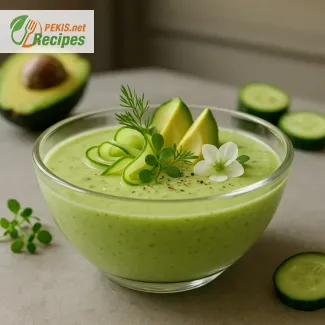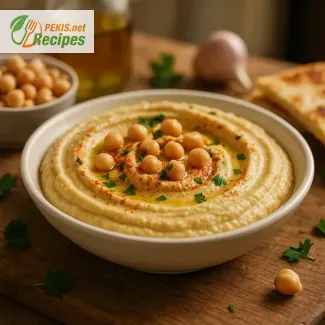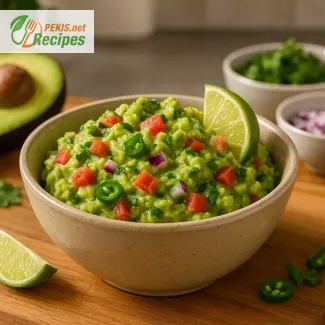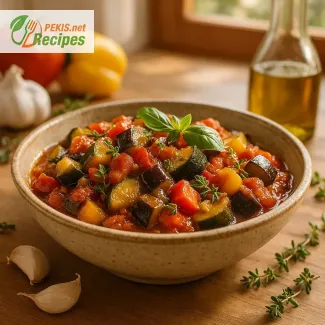Serves 8, prep 20 min, cook 0 min, total 20 min. Haitian Pikliz combines shredded cabbage, carrots, onions, garlic, and Scotch bonnet peppers in a sharp mix of vinegar and lime juice for a crunchy, fiery condiment. Its bold acidity cuts through rich dishes like griot or fried plantains, making it a versatile side. Best when left to marinate for 24 hours, it keeps for weeks in the fridge and can be frozen up to 2 months. A spoonful of this vibrant pickle adds authentic Caribbean heat and freshness to any meal.
PEKIS – professional chef and recipe developer with over 25 years of experience, specialized in European and international cuisine. I’ve spent years exploring Caribbean food traditions, and pikliz has always stood out to me as more than just a side dish – it’s a flavor booster that transforms simple meals. Working with Scotch bonnet peppers and pickling techniques, I’ve refined this recipe to keep its authentic heat while balancing it with crisp vegetables and sharp acidity.

Discovering the Flavors of Haitian Pikliz
A spicy Caribbean condiment with vibrant pickled vegetables
Pikliz is one of those creations that instantly transforms a dish with its fiery tang and crunch. At its heart, it is a medley of cabbage, carrots, onions, Scotch bonnet peppers, vinegar, and spices, carefully balanced to create a condiment that is as bold as it is versatile. Served alongside fried plantains, griot, or grilled fish, this Haitian specialty offers a refreshing acidity that cuts through richness, making every bite come alive. The heat lingers just enough to excite the palate, while the pickled vegetables bring brightness and depth of flavor.
Origin and cultural significance of Pikliz
Hailing from Haiti, pikliz has deep cultural roots as both a practical preservation method and a cornerstone of local cuisine. In the Caribbean, where warm climates encourage creativity with pickling, Haitians elevated simple vegetables into something extraordinary. For generations, families have kept jars of pikliz on their tables, each recipe slightly different, passed down through tradition. The use of Scotch bonnet peppers not only delivers intense heat but also represents the connection to Caribbean terroir and heritage. Today, pikliz is celebrated not just in Haiti but also across diaspora communities, where it continues to symbolize comfort, resilience, and the vibrant flavors of the islands.
Why this Haitian condiment stands out
- Balanced heat and acidity: The fiery spice of peppers is tamed by vinegar’s sharpness.
- Crunchy texture: Vegetables remain crisp even after marinating.
- Versatility: Works with meats, seafood, sandwiches, or as a salad topping.
- Authenticity: Reflects centuries of Haitian culinary tradition.
- Simple preparation: Minimal ingredients transform into something remarkable.
Storage and make-ahead guide
- Store at room temperature for up to 2 days in a sealed glass jar.
- Keep refrigerated to maintain freshness for several weeks.
- Freeze in airtight containers for up to 2 months.
- For reheating small portions, warm gently in an oven at 150 °C for 8–10 minutes to revive flavors without losing crunch.
Key elements that define Pikliz
Scotch bonnet peppers
These fiery peppers are essential to authentic pikliz. Their fruity heat distinguishes them from other chilies, creating a complex warmth that lingers.
Vinegar base
The vinegar solution acts as both a preservative and a flavor enhancer, pulling the sharpness into every strand of cabbage and carrot, ensuring the condiment is vibrant with each bite.
Crunchy vegetables
Cabbage forms the bulk, while carrots and onions add sweetness and bite. This interplay of textures is what makes pikliz more than just heat – it’s a complete sensory experience.
Aromatic accents
Bay leaves, cloves, or garlic are sometimes added, infusing the liquid with subtle complexity. These touches vary by household, making every jar slightly unique.
Why you’ll love making Pikliz
- Quick to prepare and ready to enhance meals within hours.
- Naturally gluten-free and plant-based.
- Customizable heat level depending on pepper choice.
- Adds brightness to heavy, fried, or grilled foods.
- A traditional recipe that introduces authentic Haitian flavors into your kitchen.
Creative variations to explore
- Citrus twist: Add fresh lime juice for extra tang and a tropical edge.
- Herbal infusion: Incorporate thyme or parsley to layer in freshness.
- Colorful blend: Mix in bell peppers for added sweetness and visual appeal.
- Mild version: Replace Scotch bonnet peppers with milder chilies while keeping the vinegar bite.
- Fusion style: Use pikliz as a topping for tacos, burgers, or even pizza to give familiar dishes a Caribbean flair.
Culinary uses beyond tradition
While pikliz is often paired with griot, fried plantains, and rice dishes, its reach goes far wider. A spoonful can transform roasted chicken, balance fatty pork, or cut through creamy sauces. Chefs outside of Haiti have embraced it as a condiment for modern dishes, recognizing its ability to enhance umami-driven foods with brightness and heat. It can replace relish in a sandwich, serve as a vibrant side salad, or even be mixed into dressings for a bold vinaigrette.
Semantically rich entities and associations
- Cuisine: Haitian, Caribbean
- Dish type: Condiment, pickled vegetables
- Ingredients: Cabbage, carrots, onions, Scotch bonnet peppers, vinegar, garlic
- Cultural context: Haitian heritage, Caribbean preservation methods
- Flavor profile: Spicy, tangy, crunchy, vibrant
Serving suggestions for a complete experience
- Spoon alongside fried plantains for a balanced bite.
- Serve with fried pork (griot) to cut through the richness.
- Add to grilled fish or seafood for a tangy, spicy lift.
- Use as a topping on sandwiches, burgers, or tacos for a fusion twist.
- Offer as part of a charcuterie or appetizer board to surprise guests.
This vibrant Haitian specialty remains a staple for good reason: it is adaptable, bold, and deeply tied to tradition. With its balance of spice, crunch, and acidity, pikliz elevates everyday meals into something memorable, proving that the simplest ingredients can tell the most powerful culinary stories.
- Wash and prepare all vegetables. Shred the cabbage finely, julienne the carrots, and slice the onion into thin strips.
- Place the cabbage, carrots, and onion in a large bowl and mix well to combine.
- Add minced garlic and finely chopped Scotch bonnet peppers. Handle the peppers carefully, as they are very spicy.
- Season the mixture with salt, black pepper, thyme sprigs, and bay leaves. Mix again to evenly distribute the spices.
- Pour the white vinegar and lime juice over the vegetables. Toss thoroughly until everything is well coated.
- Transfer the mixture into sterilized glass jars, pressing down to eliminate air pockets.
- Seal the jars tightly and let the pikliz rest at room temperature for at least 24 hours before serving, allowing the flavors to meld.
- For the best taste, refrigerate after the initial fermentation and consume within several weeks.
FAQ questionWhat is pikliz used for?
Pikliz is a spicy Haitian condiment of pickled cabbage, carrots, onions, garlic, and Scotch bonnet peppers. The bright acidity and crunchy texture cut through rich foods like griot (fried pork), fried plantains, roasted chicken, and grilled fish. Use it like a table pickle: spoon alongside mains, pile onto sandwiches and tacos, or stir into dressings to add Caribbean heat and freshness.
FAQ questionHow spicy is it—and how do I control the heat?
Traditional pikliz is hot, driven by Scotch bonnet peppers. To dial it down, remove seeds and membranes, mix in bell peppers for sweetness, or swap Scotch bonnets for habanero (still hot) or Fresno/jalapeño (milder). Balance is key: keep the vinegar-lime brine strong so the flavor stays bright even with fewer chilies.
FAQ questionWhich vinegar works best?
Use distilled white vinegar for a clean, sharp bite that lets cabbage and carrots shine. For a softer profile, try apple cider vinegar (adds gentle fruitiness) or a 50:50 white vinegar–lime juice split for extra zing. Avoid dark, aged vinegars that can muddy color and overwhelm the crisp vegetable character.
FAQ questionHow long should pikliz marinate, and how long does it keep?
Let it marinate 24 hours before serving so the brine penetrates and the heat evens out. After the first day at room temperature (up to 2 days max in a sealed jar), store in the fridge for several weeks. For long-term storage, freeze up to 2 months; thaw overnight and revive flavor by stirring. If serving warm on the side, gently reheat jars at 150 °C for 8–10 minutes—just until aromatic, so the vegetables stay crisp.
FAQ questionCan I make pikliz less sour without losing the crunch?
Yes—keep the core acid level for safety and texture, but round the edges with 1–2 tsp sugar per jar or a splash of lime for layered acidity. Maintain the salt so the vegetables stay snappy, and avoid water-heavy dilutions that can lead to a soft, bland pickle.
FAQ questionIs pikliz gluten-free and vegan?
Pikliz is naturally gluten-free and plant-based. To serve highly sensitive guests, ensure the vinegar is certified gluten-free and use clean, sterilized glass jars. Everything else—cabbage, carrots, onions, garlic, chilies, herbs, and spices—fits a vegan profile and keeps the condiment light yet bold.
FAQ questionHow do I keep the vegetables crunchy?
Aim for fine shreds (not mush) and even cuts so the brine penetrates uniformly. Salt the mix briefly before jarring to draw out a little moisture, then pack firmly to remove air pockets. Use a cold brine (no boiling) to protect texture, and store in the refrigerator after the initial rest. Avoid over-marinating at warm temperatures; steady cool storage preserves that signature crisp bite.
Pikliz brings together crisp vegetables, fiery Scotch bonnet peppers, and sharp vinegar into a condiment that defines Haitian cooking. Every spoonful carries a balance of heat, acidity, and crunch, making it the kind of side dish that transforms fried pork, plantains, and grilled meats into vibrant meals. Its versatility stretches even further, adding brightness to sandwiches, tacos, and roasted vegetables.
The beauty of pikliz lies in its simplicity and authenticity. With just a handful of everyday ingredients, it delivers layers of flavor that feel both bold and refreshing. The combination of cabbage, carrots, onions, and garlic builds a foundation of texture and sweetness, while the chilies bring the unmistakable kick that keeps the palate alive.
Beyond flavor, this Haitian staple also speaks to tradition and heritage. Generations have passed down their own variations, adjusting the level of heat or adding herbs, but always keeping the soul of the dish intact. Making it at home is more than preparing a pickle—it’s about connecting to a culinary story that continues to inspire kitchens worldwide.
Keeping a jar of pikliz ready in the fridge ensures that every meal has an instant upgrade. Whether spooned over roasted fish, served with fried snacks, or mixed into sauces, it adds the bright acidity and spicy punch that keeps food exciting. Its long shelf life and adaptability make it as practical as it is delicious.
What makes pikliz unforgettable is its ability to embody the spirit of Caribbean cooking: bold flavors, fresh ingredients, and a celebration of balance. It’s proof that with the right mix of vegetables, heat, and acid, even the simplest dishes can become extraordinary.
Allergens present in the recipe:
- None naturally present.
- Gluten-free by default.
Substitution tips for allergens and gluten:
- If preparing for highly sensitive gluten-free diets, ensure vinegar is certified gluten-free.
- Replace Scotch bonnet peppers with milder chili varieties for less spice-sensitive diets.
- Vitamin C 25 mg – strengthens the immune system and supports collagen production.
- Vitamin A 1800 IU – essential for vision and skin health.
- Vitamin K 40 µg – important for blood clotting and bone strength.
- Potassium 250 mg – helps regulate blood pressure and fluid balance.
- Calcium 40 mg – supports bone density and nerve function.
- Magnesium 18 mg – contributes to muscle function and energy production.
- Iron 0.6 mg – assists in oxygen transport in the blood.
- Capsaicin 8 mg – reduces inflammation and boosts metabolism.
- Beta-carotene 2 mg – protects cells from oxidative stress and supports eye health.
- Quercetin 5 mg – aids cardiovascular health and has anti-inflammatory properties.
- Lutein 1 mg – supports vision and reduces risk of age-related eye disease.





